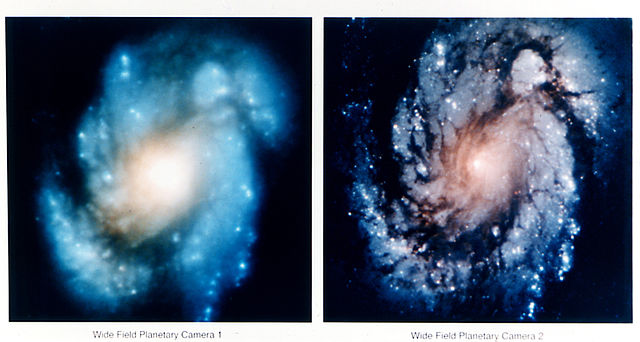 |
This is a file from the Wikimedia Commons. Information from its description page there is shown below.
Commons is a freely licensed media file repository. You can help.
|
| Description |
English: This comparison image of the core of the galaxy M100 shows the dramatic improvement in Hubble Space Telescope's view of the universe after the first Hubble Servicing Mission in December 1993. The new image, taken with the second generation Wide Field and Planetary Camera (WFPC-2) installed during the STS-61 Hubble Servicing Mission, beautifully demonstrates that the camera's corrective optics compensate fully for the optical aberration in Hubble's primary mirror. With the new camera, the Hubble explored the universe with unprecedented clarity and sensitivity, and fulfilled its most important scientific objectives for which the telescope was originally built.Image on right: The core of the grand design spiral glazy M100, as imaged by WFPC-2 in its high-resolution channel. WRPC-2's modified optics corrected Hubble's previously blurry vision, allowing the telescope for the first time to cleanly resolve faint structures as small as 30 light-years across in a galaxy tens of millions of light-years away. The image was taken on December 31, 1993.
Image on left: For comparison, a picture taken with a WFPC-1 camera in wide-field mode on November 27, 1993, just a few days prior to the STS-61 servicing mission. The effects of optical aberration in HST's 2.4-meter primary mirror blur starlight, smear out fine detail, and limit the telescope's ability to see faint structure. Both Hubble images were "raw," they were not processed using computer image reconstruction techniques that improved aberrated images made before the servicing mission. The Wide Field and Planetary Camera-2 was developed by the Jet Propulsion Laboratory and managed by the Goddard Space Flight Centre for NASA's Office of Space Science.
|
| Date |
31 December 1993 |
| Source |
Great Images in NASA Description |
| Author |
NASA |
Permission
( Reusing this file) |
| Public domainPublic domainfalsefalse |
 |
This file is in the public domain because it was solely created by NASA. NASA copyright policy states that "NASA material is not protected by copyright unless noted". (See Template:PD-USGov, NASA copyright policy page or JPL Image Use Policy.) |
|
|
|
Warnings:
- Use of NASA logos, insignia and emblems are restricted per US law 14 CFR 1221.
- The NASA website hosts a large number of images from the Soviet/ Russian space agency, and other non-American space agencies. These are not necessarily in the public domain.
- Materials based on Hubble Space Telescope data may be copyrighted if they are not explicitly produced by the STScI. See also {{ PD-Hubble}} and {{ Cc-Hubble}}.
- The SOHO (ESA & NASA) joint project implies that all materials created by its probe are copyrighted and require permission for commercial non-educational use.
- Images featured on the Astronomy Picture of the Day (APOD) web site may be copyrighted.
|
|
 |
This image or video was catalogued by Goddard Space Flight Centre of the United States National Aeronautics and Space Administration (NASA) under Photo ID: GPN-2002-000064 AND Alternate ID: 94-HC-2.
This tag does not indicate the copyright status of the attached work. A normal copyright tag is still required. See Commons:Licensing for more information.
|
File usage
The following pages on Schools Wikipedia link to this image (list may be incomplete):
Schools Wikipedia has been carefully checked to give you the best learning experience. SOS Children believes that a decent childhood is essential to a happy, healthy. Our community work brings families new opportunities through education, healthcare and all manner of support. You can help by sponsoring a child.





